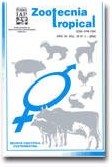
|
Zootecnia Tropical
Instituto Nacional de Investigaciones Agrícolas Venezuela
ISSN: 0798-7269
Vol. 19, No. s1, 2001, pp. 219-228
|
 Bioline Code: zt01030
Bioline Code: zt01030
Full paper language: Spanish
Document type: Research Article
Document available free of charge
|
|
|
Zootecnia Tropical, Vol. 19, No. s1, 2001, pp. 219-228
| en |
Influenced of suckling length on the milk yield in ewes and the growth of lambs
Zoraida Rondón M.
Abstract
In order to evaluate the effect of suckling length on ewes milk yield and the growth of their lambs, a trial was carried out with a cross over design using 14 West African ewes, in two consecutive lactation. The treatments were weaning at 42 days (A) and weaning at 70 days (B). The restricted suckling was carried out from the fourth day after lambing and the ewes were hand milked (Monday to Friday) after 8 hours of separation from lambs (0700 to 1500 h). Ewes were fed ad libitum chopped grass and 500 g/d of concentrate (20% CP). Were milked until their production was at least 100 g/d. From the third week of age until the end of the trial, the lambs had ad libitum access to a complete feed (25% PC). Significant differences were not observed (P>0.05) for milk yield extracted by milking up to 42 days after lambing (4.45 vs. 4.3 kg), between 43 - 70 days (2.91 vs. 2.13 kg) and during all lactation (8.79 vs. 10.03 kg). However, early weaning caused a significant reduction (P<0.01) in days of lactation (51.2 vs. 68.7 days). Lambs birth weight, at 42, 70 and at 140 days were of 3.21, 8.63, 12.03 and 24.5 kg for A and 3.14, 8.84, 11.6 and 24.6 kg for B; with no significant differences between the treatments (P>0.05). It is conclude that early weaning in West African ewes with restricted suckling didn't affect the milk production, neither the growth of the lambs .
Keywords
ewes, West African, milking, suckling length, lambs
|
| |
| es |
Restricción del amamantamiento y tiempo de destete sobre la producción de leche al ordeño de ovejas West African
Zoraida Rondón M.
Resumen
Con el fin de determinar el efecto de la duración del amamantamiento, sobre la cantidad de leche ordeñada de ovejas y el crecimiento de sus corderos, se realizó un ensayo con un diseño cruzado, utilizando 14 ovejas West African durante dos partos consecutivos. Los tratamientos fueron: destete a 42 días (A) y destete a 70 días (B). Se restringió el amamantamiento desde el cuarto día postparto y las ovejas se ordeñaron a mano (lunes a viernes), después de ocho horas de separar los corderos (07:00 a 15:00 h). La alimentación consistió en pasto de corte y 500 g/oveja/día de concentrado (20% PC). El ordeño se efectuó hasta que produjeron al menos 100 g/día. Desde la tercera semana de edad los corderos tuvieron acceso a un alimento completo (25% PC). No hubo diferencias (P>0,05) entre A y B para la cantidad de leche ordeñada hasta 42 días postparto (4,45 vs. 4,30 kg), entre 43 y 70 días (2,91 vs. 2,13 kg), ni durante toda la lactancia (8,79 vs. 10,03 kg). Sin embargo, el destete precoz redujo (P<0,01) la duración de la lactancia (51,2 vs. 68,7 días). Los pesos de los corderos al nacer, 42, 70 y 140 días de edad fueron 3,21; 8,63; 12,03 y 24,5 kg para A y 3,14; 8,84; 11,6 y 24,6 kg para B; sin diferencias entre tratamientos (P>0,05). Se concluye que el destete precoz en ovejas West African con amamantamiento restringido no afectó la producción de leche al ordeño, ni el crecimiento de sus corderos.
Palabras-clave
ovejas, destete precoz, ordeño, amamantamiento restringido, corderos
|
| |
© Copyright 2001 - Zootecnica Tropical. Free full-text also available online at http://www.ceniap.gov.ve/bdigital/ztzoo/ztindice.htm
Alternative site location: http://www.sian.inia.gob.ve/repositorio/revistas_ci/ZootecniaTropical/ztindice.htm
|
|
